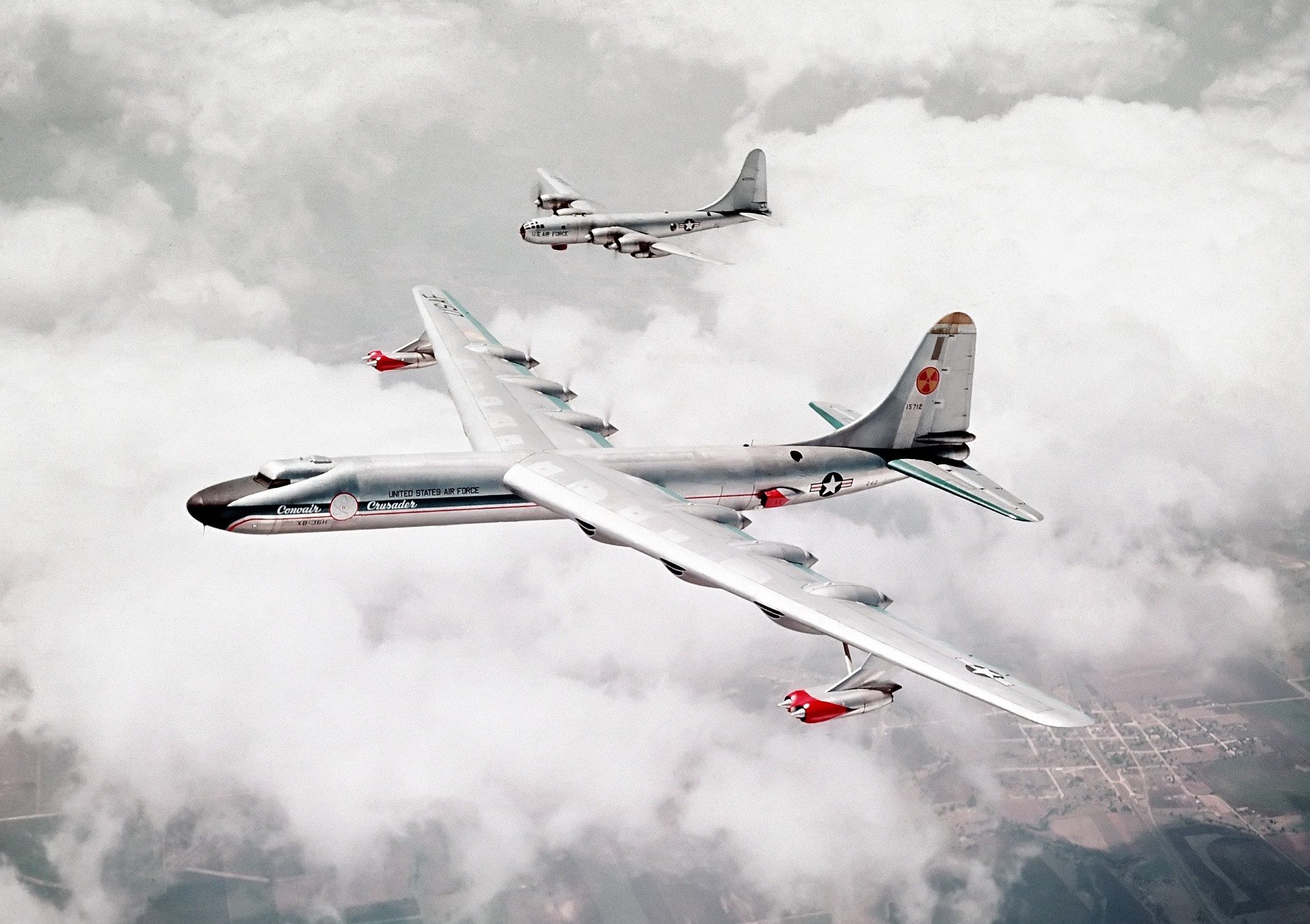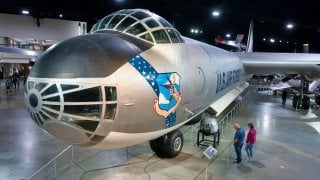Convair B-36 Peacemaker: Largest Mass-Produced Piston-Engined Bomber Ever
The Convair B-36 Peacemaker was the largest mass-produced piston-engined bomber ever, developed during WWII and serving as a nuclear deterrent during the early Cold War.
Summary: The Convair B-36 Peacemaker was the largest mass-produced piston-engined bomber ever, developed during WWII and serving as a nuclear deterrent during the early Cold War.

-It boasted a 230-foot wingspan, six rear-facing propeller engines, and four bomb bays. Entering service in 1948 with the Strategic Air Command, it was designed to strike targets 5,000 miles away. Although never used in combat, its sheer presence was a strategic asset.
-The B-36 was retired by 1959, replaced by the B-52 Stratofortress. Four Peacemakers survive in museums today.
Why the B-36 Bomber Matters
Today the Russian Aerospace Forces operates the Tupolev Tu-95 (NATO reporting name "Bear"), a long-range bomber that first entered service in 1952. It remains the only propeller-powered bomber in operation today. It was developed with propeller-driven engines due to the fact that jet engines in the early 1950s simply burned through fuel far too quickly, and the Soviet Air Force lacked the capability to refuel its long-range aircraft in flight.
The Tu-95 was meant to fly slow and steady, able to fly a distance of 5,000 miles and strike targets within the United States from territory within the former Soviet Union. However, while the Tu-95 has the distinction of being the last propeller-powered bomber to remain in service, it was a United States Air Force aircraft that was the largest mass-produced piston-engined bomber ever produced.
That aircraft was the Convair B-36 Peacemaker, which had the longest wingspan of any combat aircraft at 230 feet (70 meters). Although it was in service from 1949 to 1959, it was never used in combat – but as it was designed to carry nuclear weapons without aircraft modifications, it arguably lived up to the moniker by serving as a deterrent to the Soviet Union and the People's Republic of China during the early stages of the Cold War.
What is also notable is that though it is remembered for its service that coincided with the early days of rock 'n roll, it was actually developed just as the United States saw it would be dragged into the Second World War. Designs for the B-36 began in 1941 when Washington wasn't worried about striking Soviet targets, but rather those in Nazi-controlled Europe.
The Need for a Truly Long-Range Bomber
The U.S. Army Air Corps (later Army Air Forces) called for a strategic bomber with intercontinental range as there was the question of the stability of overseas bases. Fearing that the UK could fall to the Nazis, the B-36 would need to be able to fly from bases in the United States or Canada.
But that was hardly the only consideration. Because of the distance, the bomber was to make every trip count – and the specifications called for the Peacemaker to carry a bomb load of 10,000 pounds, delivered to a target 5,000 miles away, and take off from a 5,000-foot-long runway.
In November 1941, Consolidated Vultee (later Convair) won the contract with its Model 36 design – beating out Boeing's Model 385. With its wingspan of 230 feet, and powered by six rear-racing compound 28-cylinder Pratt & Whitney R-4360 "XWasp" air-cooled radial engines for takeoff, as well as a fuselage length of 163 feet equipped with four bomb bays with a maximum capacity of 87,200 pounds, the aircraft was truly a leap forward in aircraft design. It was described as dwarfing every other aircraft in the Army Air Force's arsenal, including the Boeing B-29 Superfortress, and one pilot even compared flying the aircraft to "sitting in a bay window flying an apartment house."
Arguably the B-36 was ahead of its time, which explained why it didn't arrive in time for the Second World War – but it was exactly what the U.S. military needed as a powerful deterrent against Soviet aggression, even though each cost around $3.6 million, a not-so-princely sum for the time.
The B-36 Peacemaker officially entered service with the Strategic Air Command (SAC) in 1948, but due to lingering problems, the B-36 units were not fully operational until 1951.
A total of 385 B-36 aircraft were constructed (including prototypes), and as noted, its service was short-lived – at least compared to the aforementioned Tu-95 and the United States Air Force's B-52 Stratofortress, the latter replacing the Peacemaker. A planned civilian model didn't get very far, even as Pan-Am expressed interest.
Today, just four intact Peacemakers survive. That includes one in the collection of the Castle Air Museum in Atwater, California, while another is at the Strategic Air Command and Aerospace Museum in Ashland, Nebraska. The final B-36 to roll off the assembly line is now in the collection of the Pima Air and Space Museum, adjacent to Davis–Monthan Air Force Base in Tucson, Arizona.
The very last flight of the B-36 saw B-36J (52-2220) flown from Davis-Monthan AFB to the National Museum of the United States Air Force at Wright-Patterson AFB, Ohio, on April 30, 1959. That aircraft is now on display in the Cold War gallery, alongside the only surviving example of the massive 9 ft (2.7 m) lower main gear strut, single wheel, and tire that was used on the original XB-36 prototype. We can only wonder if the visitors who take in this massive aircraft can fully appreciate that it may have been one of the reasons the Cold War didn't turn hot – the B-36 Peacemaker truly helped keep the peace.
Author Experience and Expertise: Peter Suciu
Peter Suciu is a Michigan-based writer. He has contributed to more than four dozen magazines, newspapers, and websites with over 3,200 published pieces over a twenty-year career in journalism. He regularly writes about military hardware, firearms history, cybersecurity, politics, and international affairs. Peter is also a Contributing Writer for Forbes and Clearance Jobs. You can follow him on Twitter: @PeterSuciu. You can email the author: [email protected].


